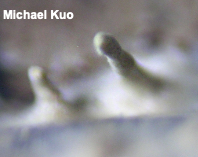| Major Groups > Oddballs & Misfits / Clubs & Corals > Akanthomyces aculeatus |

|
Akanthomyces aculeatus [ Ascomycota > Sordariomycetes > Cordycipitaceae > Akanthomyces . . . ] by Michael Kuo Here's an idea: when you die, a fungus—one that may have made you sick and killed you—will begin to spread on your corpse, creating a thick mat. Then little bumps will appear. The bumps will turn into little cones. The cones will grow and become towering spear-shaped projections, reaching twice your body's height, covered with powdery dust that contains tiny clones, ready to propagate new monsters that will infect your babies and wait until they grow up to kill them. Good thing you're not a moth, like the poor sucker in the illustrations, for whom my horror story was a reality. Akanthomyces aculeatus is one gruesome fungus, recognized by its dull yellow colors and, well, the fact that it covers moths and erects long, skinny spikes on their corpses. Akanthomyces aculeatus is an anamorph—an asexual stage of a fungus that reproduces by cloning itself with asexual spores (conidia). However, the precise telomorph, or sexual stage, is not currently known. Akanthomyces tuberculatus is similar in appearance and was once a suspected telomorph for Akanthomyces aculeatus, but it has more recently been shown to be separate. Such questions have been made more pertinent by recent changes in the rules for nomenclature. Since 2011 the rules require "ending . . . dual nomenclatural systems for pleomorphic fungi" (Kepler and collaborators, 2017); previously, anamorphs and telomorphs were often placed in different genera, as different species, despite representing the same organism in different stages of its life cycle. Thanks to Sondra Jackson and Susan Moody for collecting, documenting, and preserving Akanthomyces aculeatus for study; their collections are deposited in The Herbarium of Michael Kuo. Description: Ecology: Parasitic on adult moths; summer and fall, or over winter in warm climates; apparently fairly rare; distribution uncertain, but in North America fairly widely distributed east of the Rocky Mountains. The illustrated and described collections are from Maryland and Minnesota. Fruiting Body: At first a mat of dull yellow material, covering the body of a moth (often binding it to the substrate below it), with a bald surface; bumpy projections emerging and extending into cylindric or club-shaped, individual extensions (synnema) that then extend further, becoming spear-shaped and measuring 8–15 mm x 0.5–1 mm; surface dull, pale yellow, bald at first but becoming dusted with powder with maturity. Microscopic Features: Conidia 2.5–3 x 2 µm; broadly ellipsoid before germination; smooth; hyaline in KOH. Tramal hyphae 1.5–3 µm wide, smooth, moderately thick-walled (walls to 0.5 µm); hyaline to golden yellow in KOH. Phialides arising in a palisade, perpendicular to tramal hyphae; up to about 15 x 5 µm; septate; cylindric to clavate or subfusiform; 1-sterigmate; smooth; hyaline in KOH. REFERENCES: H. Lebert, 1858. (Mains, 1950; Sung et al., 2007; Beug et al., 2014; Kepler et al., 2017; Elliott & Stephenson, 2018.) Herb. Kuo 09191801. This site contains no information about the edibility or toxicity of mushrooms. |
© MushroomExpert.Com |
|
Cite this page as: Kuo, M. (2022, August). Akanthomyces aculeatus. Retrieved from the MushroomExpert.Com Web site: http://www.mushroomexpert.com/akanthomyces_aculeatus.html |








